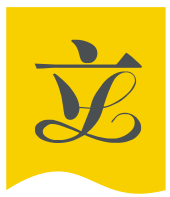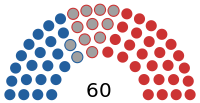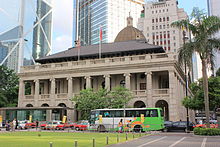- Legislative Council of Hong Kong
-
Legislative Council Traditional Chinese 立法會 Simplified Chinese 立法会 Transcriptions Mandarin - Hanyu Pinyin Lìfǎ Huì Cantonese (Yue) - Jyutping laap6 faat3 wui5 - Yale Romanization Laahp-faat Wúih Name before 1997 Chinese 立法局 Transcriptions Mandarin - Hanyu Pinyin Lìfǎ Jú Cantonese (Yue) - Jyutping laap6 faat3 guk6 - Yale Romanization Laahp-faat Guhk 
Politics and government of Hong Kong Basic Law
Chief Executive: Donald Tsang
Government
Chief Secretary: Stephen Lam
Financial Secretary: John Tsang
Secretary for Justice: Wong Yan-lung
Executive Council
Convenor of unofficials: Ronald Arculli
Bureaus, depts, etc.
Political Appointments Accountability System
Legislative Council
President: Jasper Tsang
Geographical constituency
Functional constituency
Elections
Political parties
Pan-democracy camp
Pro-Beijing camp
Judiciary
Court of Final Appeal
Chief Justice: Geoffrey Ma
High Court
Districts
District Councils
Human rights
Foreign relations
Universal suffrageOther Hong Kong topics Culture - Economy
Education - Geography - History
Hong Kong PortalThe Legislative Council is the unicameral legislature of Hong Kong.
History
The Legislative Council of Hong Kong was set up in 1843 as a colonial legislature under British rule. Hong Kong's first constitution[1], in the form of Queen Victoria's Letters Patent which was entitled the Charter of the Colony of Hong Kong, authorized the establishment of the Legislative Council to advise the Governor's administration. The Council had four Official Members when it was first established.
The first direct elections of the Legislative Council were held in 1991. The Legislative Council became a fully elected legislature for the first time in its history in 1995.
To prepare for the handover of the sovereignty of Hong Kong from the British government to the Chinese government, a Provisional Legislative Council was established by the Preparatory Committee for the Hong Kong Special Administrative Region (HKSAR) under the National People's Congress of the People's Republic of China in 1996. The Provisional Legislative Council, in operation from January 1997 to June 1998, initially held its meetings in Shenzhen. The Legislative Council of the HKSAR was established in 1998 under The Basic Law of the HKSAR. The first meeting of the Council was held in July of the same year in Hong Kong. Since The Basic Law came into effect, four Legislative Council elections have been held, with the most recent election being held in September 2008. A by-election was held in May 2010.
The Legislative Council Building
The Legislative Council of Hong Kong has been housed in the Old Supreme Court building in Central Hong Kong since 1985.
The statue on the Legislative Council Building is a replica of the one erected on the Old Bailey of London - a depiction of the goddess of justice, Themis, and a legacy from the former Supreme Court.
Unlike many other former and current Commonwealth legislatures, the Hong Kong Legislative Council does not have a ceremonial mace placed in its chambers. However, the high courts of Hong Kong use a mace to open sessions, and it represents the authority and powers of the court.
New developments
To provide a long-term solution to the space shortage problem facing both the Government and the Legislative Council, the Government commissioned the Tamar Development for the design and construction of the Central Government Complex, the Legislative Council Complex and other ancillary facilities in 2008. Work for the project is scheduled for completion in 2011. The Legislative Council Complex will comprise a low block and a high block. Low block which will be named as the Council Block mainly houses conference facilities including the Chamber, major conference rooms, and communal facilities such as Library, Cafeteria and education facilities. The range of education facilities for visit by the public includes Video Corner, Visitors' Sharing Area, Exhibition Area, Children's Corner, Viewing Gallery and Access Corridors, Memory Lane, Education Activities Rooms and Education Galleries. The high block which will be named as the Office Block mainly houses offices for Members and staff of the Legislative Council Secretariat.
Powers and functions
The major functions of the Legislative Council are to enact, amend or repeal laws, examine and approve budgets, approve taxation and public expenditure, and monitor the work of the Government. Under The Basic Law (Article 73), the Legislative Council is given additional power to endorse the appointment and removal of the judges of the Court of Final Appeal and the Chief Judge of the High Court, and to impeach the Chief Executive if he or she has committed serious breach of law or dereliction of duty.
Membership composition
The Legislative Council consists of 60 elected Members. The term of office of a Member is four years, except for the first term (1998 to 2000) when it was set to be two years (Article 69 of The Basic Law).
In both the 2008 and 2004 elections, 30 Members were directly elected by universal suffrage from geographical constituencies (GCs) and 30 were elected from functional constituencies (FCs). In the 2000 election, 24 were directly elected, six elected from an 800-member electoral college known as the Election Committee of Hong Kong, and 30 elected from FCs. According to The Basic Law, while the method for forming the Legislative Council shall be specified in accordance with the principle of gradual and orderly progress, the ultimate aim is to elect all Council Members by universal suffrage (Article 68 of The Basic Law of Hong Kong).
Constituencies
Geographical constituencies
The GC seats are returned by universal suffrage. The voting system adopted in the electoral districts is a system of party-list proportional representation, with seats allocated by the largest remainder method using the Hare quota as the quota for election.
The party-list proportional representation system is the most widely used form of proportional representation systems to facilitate the formation of a representative legislature. There were 3.37 million registered electors in the 2008 election.
Geographical constituencies No. of Seats 1998 2000 2004 2008 2012* Hong Kong Island 4 5 6 6 7 Kowloon East 3 4 5 4 5 Kowloon West 3 4 4 5 5 New Territories East 5 5 7 7 9 New Territories West 5 6 8 8 9 Total 20 24 30 30 35 * = Estimate
Functional constituencies
There are 28 FCs in the Legislative Council, representing various sectors of the community which are considered playing a crucial role in the development of Hong Kong.
Since the 2000 election, 27 FCs have returned one Member, except for the Labour FC which has returned three Members, giving a total of 30 FC seats.
- Heung Yee Kuk
- Agriculture and fisheries
- Insurance
- Financial services
- Transport
- Accountancy
- Finance
- Education
- Legal
- Information technology
- Medical
- Health services
- Architectural, surveying and planning
- Real estate and construction
- Social welfare
- Tourism
- Commercial (first)
- Commercial (second)
- Industrial (first)
- Industrial (second)
- Import and export
- Wholesale and retail
- Textiles and garment
- Sport, performing arts, culture and publication
- Catering
- District Council
- Labour
A simple plurality system is adopted for 23 FCs, with an eligible voter casting one vote only. The exceptions are the Labour FC in which a voter may cast up to three votes, thereby creating a block vote, and the Heung Yee Kuk, Agriculture and Fisheries, Insurance, and Transport FCs where a preferential elimination system is used due to the small number of voters. In the preferential elimination system, a voter must indicate preferences rather than approval/disapproval or a single choice.
President of the Legislative Council
Main article: President of the Legislative Council of Hong KongFrom the establishment of the Legislative Council in 1843 to 1993, the Governor was the President and a Member of the Council, and until 1917 the Governor was required to act with the advice but not necessary the consent of the Legislative Council. The Letters Patent of 1917 changed such practice by requiring the Governor to act "with advice and consent" of the Legislative Council.
Under The Basic Law (Article 72), the President has the powers and functions to preside over meetings, decide on the agenda, including giving priority to government bills for inclusion in the agenda, decide on the time of meetings, call special sessions during the recess, call emergency sessions on the request of the Chief Executive, and exercise other powers and functions as prescribed in the rules of procedure of the Legislative Council.
The President of the Legislative Council has to meet the eligibility requirements set out in The Basic Law that he or she shall be a Chinese citizen of not less than 40 years of age, who is a permanent resident of the HKSAR with no right of abode in any foreign country and has ordinarily resided in Hong Kong for a continuous period of not less than 20 years.
The President is elected by and from among Council Members. The first President (1997-2008) is Mrs Rita Fan Hsu Lai-tai, who is also the first female President of the Legislative Council.
Members of the Legislative Council
Main article: Hong Kong legislative election, 2008The Legislative Council is primarily composed of Chinese citizens who are permanent residents of the HKSAR with no right of abode in any foreign country. Nevertheless, permanent residents of the HKSAR who are not of Chinese nationality or who have the right of abode in foreign countries may also be Members, provided that the proportion of such Members does not exceed 20% of the total membership of the Legislative Council.
Summary of the 7 September 2008 Legislative Council Election
Results of Geographical Constituency Election
Geographical constituencies Registered Electors Voter Turnout Voter Turnout Rate (%) Overall 3,372,007 1,524,249 45.20 Hong Kong Island 627,657 314,870 50.17 Kowloon East 540,649 237,936 44.01 Kowloon West 440,335 207,765 47.18 New Territories East 820,205 362,959 44.25 New Territories West 943,161 400,719 42.49 Results of Functional Constituency Election
Functional Constituencies Registered Electors Voter Turnout Voter Turnout Rate (%) Overall 212,227 126,819 59.76 Insurance 144 115 79.86 Transport 178 161 90.45 Education 90,693 54,315 59.89 Legal 6,111 3,872 63.36 Accountancy 22,276 13,864 62.24 Medical 10,606 6,879 64.86 Health Services 36,968 18,192 49.21 Engineering 8,323 5,537 66.53 Architectural, Surveying and Planning 6,147 3,959 64.41 Social Welfare 12,519 8,584 68.57 Tourism 1,261 909 72.09 Commercial (First) 1,040 694 66.73 Textiles and Garment 3,710 2,061 55.55 Wholesale and Retail 6,074 3,131 51.55 Information Technology 5,749 4,137 71.96 District Council 428 409 95.56 Note: Fourteen candidates in 12 FCs were returned uncontested.
Constitutional development
Following the passage by the Legislative Council a two-thirds majority of the motions put forth by the Government concerning the draft amendments to the methods for selecting the Chief Executive and forming the Legislative Council in 2012 on 24 and 25 June 2010 respectively, the Chief Executive Election (Amendment) Bill 2010 and the Legislative Council (Amendment) Bill 2010 to implement the two electoral methods for 2012 were passed on 3 and 5 March 2011 respectively. The objects of the Chief Executive Election (Amendment) Bill 2010 are to increase the number of seats for each Election Committee sector to 300, allocate the additional seats among the Election Committee subsectors and make changes in relation to District Councils and Chinese medicine subsectors and other related matters. The objects of the Legislative Council (Amendment) Bill 2010 are to enlarge the Legislative Council by adding five GC seats and creating a new District Council Functional Constituency of five seats and to make other changes related to the Legislative Council elections.Proposed replacement mechanism for filling vacancies in the Legislative Council
In January 2010, five Council Members from each of the five GCs resigned to trigger territory-wide by-elections for the purpose of instigating a so-called “referendum”. They stood in the by-elections and were all re-elected. Subsequently, the Government proposed a replacement mechanism where a vacancy arising mid-term in the Legislative Council would be filled by the first candidate who had not yet been elected in the list with the largest number of remainder votes. Some member of the public expressed concern on the proposal and stressed that the Government should have conducted a comprehensive public consultation on the proposal as the basic rights of the public would be affected. In July 2011, the Government published a consultation paper in which four options were proposed with regard to the arrangements for filling vacancies in the Legislative Council.Procedures for voting on bills and motions
Traditionally, the President does not vote. However, this convention is not a constitutional requirement.[2]
Private Members' bills and motions have to be passed by majorities of Members returned from GCs and Members returned from FCs respectively. This arrangement, however, is not applicable to government bills, where only a simple majority is required to secure passage.
Amendments to The Basic Law require a two-thirds vote in the Legislative Council, without a specific requirement in each group of constituencies. After passing the Council, the Basic Law amendment must obtain the consent of two-thirds of Hong Kong's deputies to the National People's Congress, and also the Chief Executive (the Chief Executive is vested with the veto power).
Seating arrangement
In a typical Council meeting, Members are seated to the left and front of the President's chair in the Chamber. The three rows to the right are reserved for government officials and other people attending the meetings.
When the council moves to the new Legco site at Tamar, members will sit facing the President (and council officers) in an arc.
Officers of the Legislative Council
Main article: List of Clerk of the Legislative Council of Hong KongServices to Members were originally provided by the Office of the Clerk to the Legislative Council which was part of the Government Secretariat. Additional support later came from other administrative units, i.e. the Unofficial Members of the Executive and Legislative Councils (UMELCO) Secretariat and its variants, in consideration of the gradually rising volume of work in Council business.
With the establishment of UMELCO in 1963, public officers were seconded to UMELCO to assist Members to deal with public complaints and build up public relations with the local community. During their secondments, public officers took instructions only from Council Members. The practice remained when the Office of the Members of the Executive and Legislative Councils (OMELCO) replaced UMELCO in 1986. In 1991, the OMELCO Secretariat was incorporated. As a result of the complete separation of membership of the Executive and Legislative Councils, OMELCO was renamed the Office of Members of Legislative Council (OMLEGCO).
The Legislative Council Commission, a statutory body independent of the Government, was established under The Legislative Council Commission Ordinance on 1 April 1994. The Commission integrated the administrative support and services to the Council by the Office of the Clerk to the Legislative Council and the OMLEGCO Secretariat into an independent Legislative Council Secretariat. The Commission replaced all civil servants by contract staff in the 1994-1995 session.
At present, the Secretariat, headed by the Secretary General, provides administrative support and services to the Council through its ten divisions. In addition to being the chief executive of the Secretariat, the Secretary General is also the Clerk to the Legislative Council responsible for advising the President on all matters relating to the procedure of the Council.
See also
- Provisional Legislative Council
- Politics of Hong Kong
- Hong Kong Legislative Council elections, 2004
- Hong Kong Legislative Council elections, 2008
- Executive Council of Hong Kong
References
- ^ http://www.legco.gov.hk/english/index.htm Paragraph three indicates Queen Victoria's Letters Patent was Hong Kong's first constitution.
- ^ Michael DeGolyer (24 July 2008+accessdate=2008-07-24). "Legco dice loaded from the start". The Standard. http://www.thestandard.com.hk/news_detail.asp?pp_cat=15&art_id=69034&sid=19876711&con_type=3&d_str=20080724&sear_year=2008.
External links
Members of the Legislative Council of Hong Kong (2008–2012) President Jasper TsangGeographical
constituenciesHong Kong IslandKowloon EastKowloon WestLee Cheuk-yan · Tam Yiu-chung · Cheung Hok-ming · Albert Ho · Albert Chan^ · Wong Kwok-hing · Leung Yiu-chung · Lee Wing-tatFunctional
constituenciesChan Kin-por · Paul Chan · Cheung Kwok-che · Cheung Man-kwong · Tommy Cheung · Chim Pui Chung · Vincent Fang · Timothy Fok · Raymond Ho · Ip Kwok Him · Ip Wai-ming · Jeffrey Lam · Lam Tai-fai · Miriam Lau · Patrick Lau · Lau Wong-fat · Joseph Lee · Andrew Leung · Leung Ka-lau · Sophie Leung · David Li · Li Fung-ying · Margaret Ng · Pan Pey-chyou · Abraham Razack · Samson Tam · Paul Tse · Philip Wong · Wong Ting-kwong · Wong Yung-kan^ denotes members who resigned in January 2010 and re-elected by the Hong Kong by-election, 2010 on 16 May 2010.Parliament of Asia Sovereign
states- Afghanistan
- Armenia
- Azerbaijan
- Bahrain
- Bangladesh
- Bhutan
- Brunei
- Burma (Myanmar)
- Cambodia
- People's Republic of China
- Cyprus
- East Timor (Timor-Leste)
- Egypt
- Georgia
- India
- Indonesia
- Iran
- Iraq
- Israel
- Japan
- Jordan
- Kazakhstan
- North Korea
- South Korea
- Kuwait
- Kyrgyzstan
- Laos
- Lebanon
- Malaysia
- Maldives
- Mongolia
- Nepal
- Oman
- Pakistan
- Philippines
- Qatar
- Russia
- Saudi Arabia
- Singapore
- Sri Lanka
- Syria
- Tajikistan
- Thailand
- Turkey
- Turkmenistan
- United Arab Emirates
- Uzbekistan
- Vietnam
- Yemen
States with limited
recognition- Abkhazia
- Nagorno-Karabakh
- Northern Cyprus
- Palestine
- Republic of China (Taiwan)
- South Ossetia
Dependencies and
other territories- Christmas Island
- Cocos (Keeling) Islands
- Hong Kong
- Macau
Categories:- Members of the Legislative Council of Hong Kong
- Dependency legislatures
- Legislative Council of Hong Kong
- Hong Kong-related lists
- Unicameral legislatures
Wikimedia Foundation. 2010.



